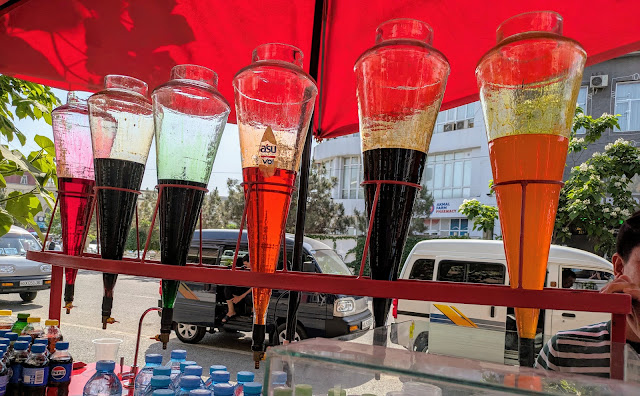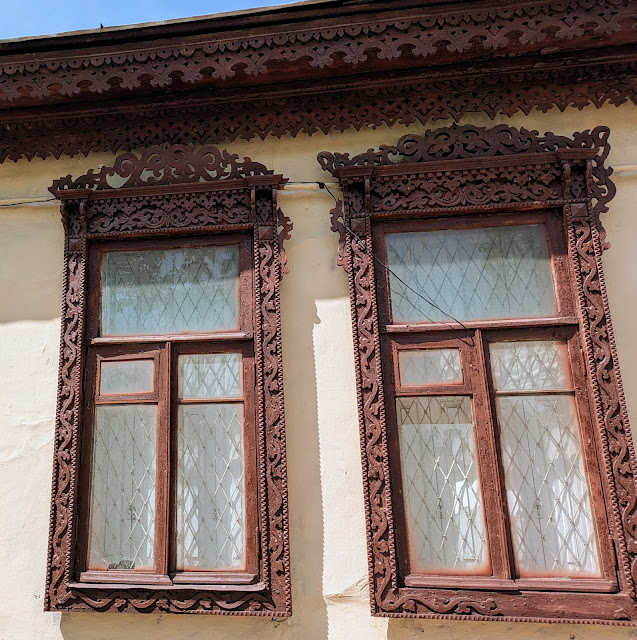The old train leaves Tashkent at 8:10 am precisely, and to end the suspense, we arrive at the Andijan station at 2:20 in the afternoon, only five minutes late.
While the train slowly chugged, swayed and lurched along, the train stations were clean and modern.
We are now in the Fergana Valley to the far east of Uzbekistan, near the Kyrgyzstan border. The view from the train window saw heavy industry, farms, vineyards, mining, and what looked like the oil or gas industry. This area was an important participant in the Silk Road.
While we saw large vineyards through the train window, we also noticed how every patch of flat land by the tracks was utilized. Here is a small patch with grapes growing.
Andijan, the city, is 2,500+ years old and is much bigger than we were expecting. Newly off the train, we are standing near the open doors of a travel agency/English language school, trying to locate the route to our hotel, when the administrator spots us and comes out. She joins us for several blocks to get us going in the right direction.
Even with her assistance, it took us a while to find the hotel, including with help from several people on the street. Looking back, we are not sure why, as there's a big red sign on the building face.
The room is well insulated from the street noise and lights below us, has A/C, comfortable beds and is decorated in a very elaborate fashion. The huge chandelier, the ceiling decoration around it and the recessed, lighted ceiling leaves us speechless and the gold wallpaper everywhere and crown molding is impressive.
Paul is sure that as soon as purchased the horn is upgraded to something many decibels higher than from the factory. A colour other than white is so unusual that we had to capture it.
Everyone drives (too) fast with one foot on the gas and one hand on the horn. Pedestrians take major risks every time they cross the street. Taxi drivers are shouting, competing for customers, and people are selling their wares on the street. From the relative calm and orderliness of Tashkent, Andijan feels loud and chaotic. It takes a day for us to get used to it and enjoy it.
One really cannot compare Andijan with Tashkent. It is said that Andijan is a more authentic experience, while Tashkent, being the capital, is a cultural, political, and economic hub and a more worldly place to visit. It was heavily influenced by Russian architecture and infrastructure planning. It has more upscale hotels and international restaurants that many tourists favour.
Andijan is more like a big neighbourhood with deep cultural roots and traditions, while people from all over Uzbekistan come to Tashkent to work.
Andijan feels more alive and more gritty. Here we see garbage on the streets, a few people (mostly the handicapped or even the aged) begging for some money and more people getting by selling second-hand tools and clothes, inexpensive trinkets and housewares.
What is common to both is the good nature and kindness of the people.
Like Tashkent, Andijan has its historic hero. Here it's Barbur. His relationship to Andijen and the complexities of what he did or didn't do are a bit beyond me, but there are statues, a museum and a park dedicated to him.
Tonight, for example, our dinner in the hotel room is from the street - a kebab, a samsa stuffed with potato and onion, a tasty fermented salad with carrots and cabbage, and one of Paul's favourites: a salad made from mild onion sliced very thinly and marinated in dressing and spices. The cost of this dinner, including beer, was a grand total of $4.07 for both of us.
One of our favourite street foods is Samsa. These packets of ever-so-light and flaky pastry are baked in a tandoor and can be stuffed with vegetables (Linda especially likes the spinach) or with meat (mostly chicken or beef) or with a combination of both.
An interesting snack is what we call 'cheese balls', but here they are known as kurt (or variations on that spelling). Note the similarity to our word curd.
These are made from dried sour milk and simply seasoned with salt or pepper. Some have a more aged and pungent taste than others. These dried balls are a perfect food for travel as long as one has liquid to drink. They have a pronounced astringent effect in the mouth, and yet the mouth tingles with the sour. We like them with beer. In the market, we see basins of the ingredients ready to be made into balls.
The produce in this market has a more from-the-farm look with dirt still attached than the polished and perfectly composed vegetables we saw in Tashkent.
And who could forget the jewel-coloured shabbat sold on the street? These are natural syrups made from pomegranate or cherries (red), mulberry (deep purple), apricot (golden yellow) and mint or tarragon (emerald green). They are made by boiling the natural fruit juices with flower petals, herbs and sugar until a concentrate is formed. When you order one, the vendor mixes some syrup with water and/or ice.
This is a good time to talk about tea in Uzbekistan. Tea is ubiquitous here.
It's the only refreshment offered at no charge on our 2nd. class train seat 'with service', while even a small bottle of water is similar to 'airport' prices.
Here, it's tradition to serve a bowl of green Uzbek tea to guests (whether invited or uninvited). In the mornings and after a heavy meal it's served hot, but cold in the hot afternoons. It opens and ends meals and is a separate "dish" during the day. There is never a day without tea, and it is always freshly brewed.
In ancient times, nomads had tea (ak-tea) brewed with milk, sugar, butter, salt and pepper for the caloric boost. Back then, tea came from a very long distance on the Silk Road, so it was expensive. Wealthy people would drink up to 20 cups of high-quality green tea a day, while poor people drank a tea (khoshak) made of two varieties of grass, cereal pepper, Chubb-tea and cinnamon.
Green tea is affordable by all now and is common throughout the country, while in Tashkent, black tea is preferred.
There is ritual and rules about who makes and serves the tea to whom, how long the tea steeps and the ratio of tea leaves to water. It is usually handed over by the server with their left hand, while the right hand, in the giving is over their heart.
Teahouses are still common on the streets here.
So, away from food and drink for a while. Linda had some health issues today, so the two things we had planned for the visit to Andijan did not happen. We enjoyed exploring neighbourhoods instead.
We are blown away by the sheer number of English language colleges here. On the main streets, there is literally one on each block, sometimes two. People see the English language as an asset.
On our outing today, we came across several old trucks like these from the soviet era, repurposed and still working. This is similar to what we saw in parts of Albania.
Again, we did not go inside the Jami complex, but that was fine as we were in awe of the outdoor ceiling
Many buildings are covered in signs like these, so there's some visual chaos added to the noise.
In both Tashkent and in Andijon, we see the love of roses. There are many archways covered in a climbing variety with smallish pink flowers. And plants that have been shaped by topiary. The bouquets of roses sold from street carts are enormous, and their wrapping can be quite elaborate. Anyone who has a little patch of dirt near their home often fills it with roses.
The big child mannequins in the window are eye-catching. In the second photo, many of the mannequins for adults are quite fancy with gold mesh faces, gold skin and other adornments.
















































Sorry to hear about your feet, Linda. So many things within reach! Sounds like you are your usual accepting selves and make the most of it. Wonderful colours, architecture, pace here!
ReplyDeleteThe feet are quite annoying, but there are always taxis when needed
ReplyDelete